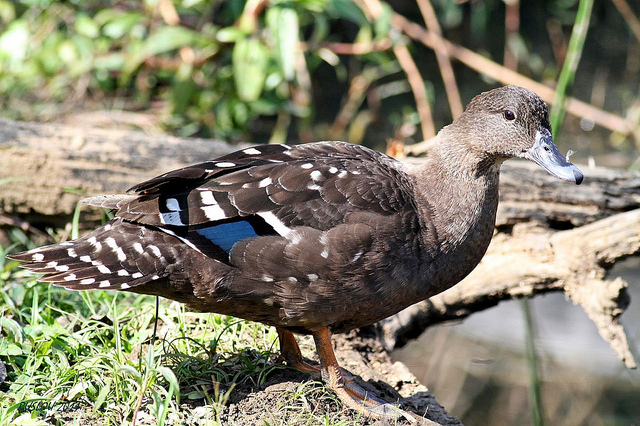
African black duck(Anas sparsa)
Phylum —chordata
Class — aves
Order — anseriformes
Family — anatidae
Genus –anas
Appearance
The African black duck is a black duck with pronounced white marks on its back, a dark bill, and orange legs and feet. A purpish-blue speculum is often visible, especially in flight. It is a medium-sized duck, length 48–57 cm, with the male the larger.
Habitat
The African black duck is mainly found in eastern and southern sub-Saharan Africa from South Africa north to South Sudan and Ethiopia with outlying populations in western equatorial Africa, in southeast Nigeria, Cameroon and Gabon.
Behavior
It is a very shy and territorial duck. It is usually seen in pairs or small flocks.
The African black duck is mostly active at dawn and dusk. It usually rests up during the day, lying well-hidden and motionless at regular sites, and taking advantage of its cryptic plumage.
The African black duck is sedentary throughout the range and only performs short seasonal movements.
Diet
It is an omnivore that feeds off of larvae and pupae usually found under rocks, aquatic animals, plant material, seeds, small fish, snails, and crabs.
Reproduction
The African black duck is monogamous with strong pair-bond, as usual in river ducks.
The breeding season varies according to the range.
The African black duck nests in single pairs. The nest is placed on the ground, very close to the water, within two meters, but usually above the flood-level. The hollow is thickly lined with down. The nest is hidden among reeds and grass on the riverbank.
The female lays 4-9 creamy-white to buff-yellow eggs. She incubates alone during 28-32 days, guarded by the male. At hatching, the chicks have black down above and buffy-white below, with white collar on upper breast and pale yellow spots on back. The bill is black. They leave the nest very soon after hatching, and the female leads them to the water once dry. She protects them and keeps them under the vegetal cover. The chicks feed by diving and may chase insects along the water. They are able to fly at 75-77 days old and become independent. The family may join the male at nocturnal roost.
In captivity
Its average lifespan in captivity is about 15 years.
They are hardy birds that are easy to breed.
For ducks, it is important to have water on their territory. The reservoir may be shallow (no more than two feet deep). For one pair of ducks, it is recommended to set aside from 50 to 100 square meters, depending on the size of the birds.
Their diet is based on wheat and bread. Grains are given as a source of calcium for breeding.
These ducks tend to hybridize, particularly with closely related species that must be kept separately from each other.
 Russian
Russian
 English
English
























